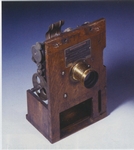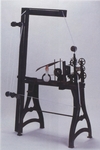This website was developed by Sarah Bither '13 and Melissa Yang '14, DHi 2011-2012 CLASS Scholars.
Origins
The two major competing motion picture machines introduced to Japan were the Cinematographe from Europe, invented by Auguste Lumiere, and the Vitascope from America, invented by Thomas Armat and C. Jenkins. The first “films” consisted merely of simple images of everyday life, such as chickens eating grain, and only ranged from a couple of tens of seconds to a few minutes. The shortness of the films combined with high ticket prices due to maintenance, importation, and marketing costs and the desire to distinguish this new product from traditional theater prompted exhibitionists to think of new ways to extend the lengths of the performances. One of these ways was to conduct a massive demonstration of how the mysterious machinery worked. This demonstration, now extending performances up to three hours, became as much a part, if not more, of the performance as the actual film reels were. Speakers were soon hired to stand next to the projector and explain to an amazed audience how this new technology worked. The speaker became the leader of the performance and the audience thus blamed him outright if any of the machinery failed. These speakers were the early ancestors of those who would eventually become culturally revered as “poets of the darkness,” the benshi. (Dym)
The original benshi, literally meaning “orator” and predating cinema, were politically ambitious men who spoke out during political meetings. Gradually, this term evolved to refer to those who orated the performances of the Cinematographe and Vitascope. The first of this type of benshi often possessed backgrounds in theater and narrative storytelling. Such was the case of Ueda Hoteiken, who performed primarily before the twentieth century and started his theatrical career as a gidayu katari, a ballad-drama chanter. Other benshi had backgrounds in sales or were former street vendors. Such people effectively sold their product with lively and colorful performances.
Such low-class artists and film’s “gimmicky” appearance, however, caused society to quickly label the early benshi profession as vulgar. At first, the advent of cinema was fascinating, but the novelty soon wore off as people claimed it lacked depth and consequently was not considered a true art form. Although many people grew to love this new form of entertainment, some critics still held onto this first harsh opinion, despite the coming evolution in both film and the role of the benshi.
As audiences grew bored with the short and simple films, filmmakers began developing and using new techniques, like editing and acting, to make longer and more entertaining narratives with more intricate plot lines. Japanese audiences started to worry about missing subtle developments or not understanding certain facts. Now, more complicated oration was needed that went beyond just stating the obvious. The benshi adjusted their performances accordingly to include a narrated introduction to the film that explained to the audience what to expect and to even provide a running commentary during the film. Similarly, as more foreign films were imported, the audience needed a guide to explain the customs, history, and traditions of the foreign culture represented in the film. Benshi also expanded on their duties by acting as translators during the film, since American and European film companies thought translating intertitles into Japanese too costly of an endeavor.
It was not considered strange that Japanese silent film was not, in fact, “silent” at all. There had long been a Japanese custom of accompanying visual entertainment with aural. Gentoo magic lantern shows, for example, had always been accompanied by narration and musical renditions on the shamisen. This custom was one of the main reasons that the silent film industry and benshi were so successful. They upheld some traditional theater elements while bridging the gap to modern commercialism and corporate business (Fujiki). The industry copied kabuki theater’s use of stylized combat fighting and oyama, male actors playing female roles. The benshi narrated in the kowairo style, similar to the lyrical performance of kabuki actors.
The adding of benshi to the experience of watching silent film was not only familiar but, in a way, expected. It was the true “silent” film, not the benshi, that would have held an odd position indeed in Japanese culture and tradition.
Some content may not display correctly on mobile devices.



